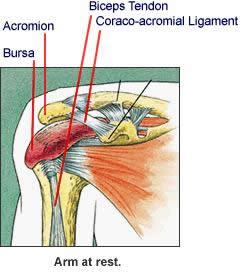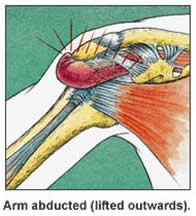
Shoulder Bursitis
Posted By irvinechiro / Date Posted: 2015-06-11
Shoulder bursitis is an inflamed shoulder bursa.

You have several bursae in your shoulder. Your bursa is a fluid filled sac that helps to reduce friction in your shoulder spaces. Your subacromial bursa is the most commonly inflamed of the shoulder bursa.
Subacromial bursitis is a common cause of shoulder pain that is usually related to shoulder impingement of your bursa between your rotator cuff tendons and bone (acromion). Your subdeltoid bursa is less commonly inflamed shoulder bursa.
What are the Symptoms of Shoulder Bursitis?
Shoulder bursitis commonly presents with the following symptoms:
- Pain on the outside of your shoulder.
- Referral of pain down your arm towards the elbow or wrist.
- Pain made worse when lying on your affected shoulder.
- Increased pain when using the arm overhead. .
- When your arm is by your side there is minimal pain and above 90° relief of pain.
How is Shoulder Bursitis diagnosed?
Your chiropractor is able to differentiate shoulder bursitis from a rotator cuff injury using manual tests. Shoulder bursitis commonly co-exists with rotator cuff tears or tendonitis.
Ultrasound scan is often the most helpful test to diagnose subacromial bursitis. Sometimes MRI scan is required to confirm the diagnosis of bursitis of the shoulder.
What Causes Shoulder Bursitis?
Bursitis around the shoulder can be caused by a repeated minor trauma such as overuse of the shoulder joint and muscles or a single more significant trauma such as a fall.
In overuse type injuries, bursitis is often associated with impingement and tendonitis(inflammation) of the rotator cuff tendons.
Specifically, the subacromial bursa lies between the coracoacromial ligament and the supraspinatus muscle and helps to reduce friction in this small space under the acromion.

 When your arm is at your side the bursa protrudes laterally and is not
normally impinged unless it is grossly inflamed.
When your arm is at your side the bursa protrudes laterally and is not
normally impinged unless it is grossly inflamed.

 When you elevate your arm further out
to the side the bursa rolls beneath the bone increasing the
impingement.
When you elevate your arm further out
to the side the bursa rolls beneath the bone increasing the
impingement.

 When you continue to elevate your arm
above shoulder height, the bursa rolls clears the impingement zone and your pain eases. However, further impingement may return at the extreme of range when
your arm is adjacent to your ear.
When you continue to elevate your arm
above shoulder height, the bursa rolls clears the impingement zone and your pain eases. However, further impingement may return at the extreme of range when
your arm is adjacent to your ear.
How Can You Prevent Shoulder Bursitis?
Eliminating the causes of impingement is the key to preventing shoulder bursitis and rotator cuff problems. Factors such as posture, muscle length, shoulder stability and rotator cuff strength need to be addressed and can be optimised with specific exercises prescribed by you chiropractor.
For more specific advice please consult your chiropractor.
Shoulder Bursitis Treatment
Shoulder bursitis is one of the most common problems that we see at Irvine Chiropractic and it is unfortunately an injury that often recurs if you return to sport or work too quickly – especially if a thorough rehabilitation program is not completed.
Your rotator cuff is an important group of control and stability muscles that maintain “centralisation” of your shoulder joint. In other words, it keeps the shoulder ball centred over the small socket. This prevents injuries such as bursitis, impingement, subluxations and dislocations.
We also know that your rotator cuff provides subtle glides and slides of the ball joint on the socket to allow full shoulder movement. Plus, your shoulder blade (scapular) has a vital role as the main dynamically stable base plate that attaches your arm to your chest wall.
Researchers have concluded that there are essentially 7 stages that need to be covered to effectively rehabilitate these injuries and prevent recurrence – these are:
Phase 1 - Early Injury Protection: Pain Relief & Anti-inflammatory Tips
In the early phase you’ll most likely be unable to fully lift your arm or sleep comfortably. Our first aim is to provide you with some active rest from pain-provoking postures and movements.
This means that you should stop doing the movement or activity that provoked the shoulder pain in the first place and avoid doing anything that causes pain in your shoulder.
You may need to have your shoulder taped to provide pain relief. In some cases it may mean that you need to sleep relatively upright or with pillow support. Your chiropractor will guide you.
Ice is a simple and effective modality to reduce your pain and swelling. Please apply for 20-30 minutes each 2 to 4 hours during the initial phase or when you notice that your injury is warm or hot.
Anti-inflammatory medication (if tolerated) and natural substances eg arnica may help reduce your pain and swelling. However, it is best to avoid anti-inflammatory drugs during the initial 48 to 72 hours when they may encourage additional bleeding.
Your chiropractor will utilise a range of pain relieving techniques including joint mobilisations, massage and dry needling to assist you during this painful phase.
Phase 2: Regain Full Range of Motion
If you protect your injured rotator cuff structures appropriately the injured tissues will heal. Inflamed structures eg (tendonitis, bursitis) will settle when protected from additional damage.
Symptoms related to shoulder bursitis may take several weeks to improve while we await healing to occur. During this time it is important to create an environment that allows you to return to normal use quickly and prevent a recurrence.
It is important to lengthen and orientate your healing scar tissue via mobilisations, massage, stretching, and light active-assisted and active exercises.
Researchers have concluded that chiropractor-assisted treatment will improve your range of motion quicker and, in the long-term, improve your functional outcome.
In most cases, you will also have developed short or long-term protective tightness of your joint capsule (usually posterior) and some compensatory muscles. These structures need to be stretched to allow normal movement.
Signs that you have full soft tissue extensibility includes being able to move your shoulder through a full range of motion. In the early stage, this may need to be passively (by someone else) e.g. your chiropractor. As you improve you will be able to do this under your own muscle power.
Phase 3: Restore Scapular Control
Your shoulder blade (scapular) is the base of your shoulder and arm movements.
Normal shoulder blade-shoulder movement - known as scapulo-humeral rhythm- is required for a pain-free and powerful shoulder function. Alteration of this movement pattern results in impingement and subsequent injury.
Your chiropractor is an expert in the assessment and correction of your scapulo-humeral rhythm.
Researchers have identified poor scapulo-humeral rhythm as a major cause of rotator cuff impingement. Any deficiencies will be an important component of your rehabilitation.
Your chiropractor will be able to guide you in the appropriate exercises for your shoulder blade.
Phase 4: Restore Normal Neck-Scapulo-Thoracic-Shoulder Function
You may find it difficult to comprehend, but your neck and upper back (thoracic spine) are very important in the rehabilitation of shoulder pain and injury.
Neck or spine dysfunction can not only refer pain directly to your shoulder, but it can affect a nerve’s electrical energy supplying your muscles causing weakness and altered movement patterns.
Plus, painful spinal structures from poor posture or injury doesn’t provide your shoulder or scapular muscles with a solid pain-free base to act upon.
In most cases, especially chronic shoulders, some treatment directed at your neck or upper back will be required to ease your pain, improve your shoulder movement and stop pain or injury returning.
Phase 5: Restore Rotator Cuff Strength
It may seem odd that you don’t attempt to restore the strength of your rotator cuff until a later stage in the rehabilitation. However, if a structure is injured we need to provide nature with an opportunity to undertake primary healing before we load the structures with anti-gravity and resistance exercises.
Having said that, researchers have discovered the importance of strengthening in a successful rehabilitation program. These exercises need to be progressed in both load and position to accommodate for which specific rotator cuff tendons are injured and whether or not you have a secondary condition such as bursitis.
Your chiropractor will prescribe the most appropriate program for you.
Phase 6 and Phase 7 are aimed at progressing to your chosen sport if you wish.
For further help or if you would like to book in for a consultation to have your shoulder examined please call 96305517.
Tweet





